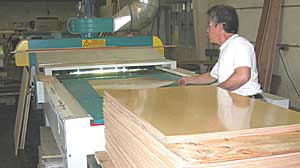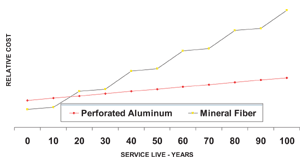Perforated Metal and Wood Ceilings: Sustainability, Acoustics, and Aesthetics
BEYOND LEED
While the LEED program incorporates many strategies for greening a building, it is hardly comprehensive. Fortunately, it allows credits for innovation in design. Here are a few sustainability strategies that apply to ceilings yet are not included in the LEED program:
Prefinishing to Eliminate Total VOCs: LEED credit EQ-4.2 can be earned for the use of paints and coatings with low levels of volatile organic compounds (VOC) emissions. As currently written, however, the LEED credit applies only to job-site applied materials. For example, a coating that is field-applied to a wood ceiling must not exceed the VOC limits established by the Green Seal program (www.greenseal.com). If the wood is factory prefinished, however, it does not qualify for the credit even though it does not release VOCs in the field.
|
Consider the case, too, of a factory-applied coating with a chemistry that releases zero VOCs. For example, UV coatings are cured with high-intensity ultraviolet light that causes polymers in the coatings to crosslink without the release of VOCs. While UV coatings have been used for many years in the furniture industry, it is only recently that a low-sheen UV coating suitable for architectural panels has been developed. The coating produces a durable, non-yellowing, and washable finish that is smoother and more consistent than field-applied coatings.
A similar observation can be made about factory-applied paints. Applicators that roller-coat metal coil, for example, use solvent recovery systems and then burn the vapors to fuel their paint curing ovens, reducing total energy used to paint panels and preventing the release of VOCs into the atmosphere.
Zero VOCs in the factory would seem to be better for the environment than a low-level of VOCs on the jobsite, irrespective of any LEED credits. This means that a designer must sometimes look beyond LEED to see the big picture necessary for sustainable construction.
Prefabrication to Reduce Construction Waste: LEED Credit MR-2 recognizes projects that divert waste materials from the construction job site. Construction waste and demolition debris generates as much as 25% of the solid waste stream in this country. While managing construction waste is important, wouldn't it be better to eliminate jobsite waste altogether?
|











